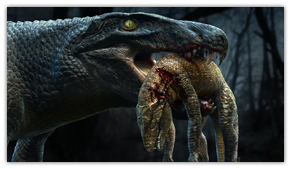 | | Aplestosuchus sordidus
Baurusuchid crocodyliform from the Cretaceous rocks (cc. 80 Ma) of the São Paulo State, with remains of a smaller crocodylian (Sphagesauridae) preserved in its abdominal region. Described in 2014 by Pedro Godoy, Felipe Montefeltro, Max langer and coleagues.
|
| | |
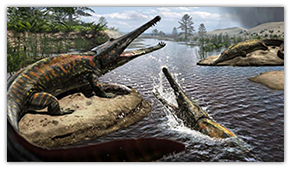 | | Australerpeton cosgriffi
Temnospondyl "amphibian" collected from Permian rocks (c. 250 My) in the Serra do Cadeado area (Paraná, Brazil). Discovered during the eighties by researchers of Universidade Federal do Rio Grande do Sul, it has been reaccessed by Estevan Eltink, Max Langer and co-workers. It was a large aquatic predator of about 2 m in length.
|
| | |
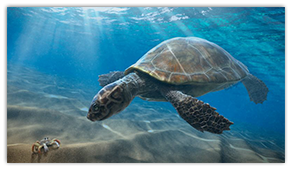 | | Bairdemys thalassica
Pleurodiran turtle collected from miocenic rocks (c. 12 My) from the Falcón state, Venezuela. The finding allowed a review of the group and the proposition of a hypothesis that those turtles were part of a marine radiation of side-neck turtles, specialized in hard prey predation, such as crustaceans and molluscs. The new species was described in 2015 by Gabriel Ferreira, Max Langer and coleagues.
|
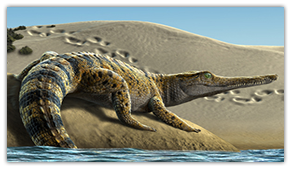 | |
Batrachomimus pastosbonensis
Paralligatoridae crocodylian collected in 2012 by the PaleoLab team in Nova Iorque, Maranhão. It comes from jurassic rocks (c. 150 My), and it is the only knownn Jurassic tetrapod from Brasil. Batrachomimus was described in 2013 by Felipe Montefeltro, Max Langer and coleagues.
|
| | |
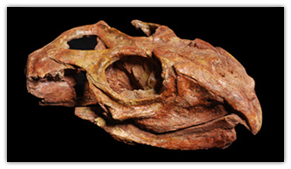 | | Bentonyx sidensis
Rhynchosaur "reptile" collected from Triassic rocks (c. 240 My) from the south coast of Devon-UK. Discovered in 2005 by University of Bristol researchers, it was redescribed by Max Langer, Felipe Montefeltro, and co-workers in 2010. The generic name honors Michael Benton, "rhynchosaur champion" and former supervisor of Max Langer.
|
| | |
 | | Brasinorhynchus mariantensis
Rhynchosaur "reptile" collected from Middle Triassic rocks (c. 235 My) of Rio Grande do Sul, Brazil. Discovered during the late eighties, it remained for more than 25 years known as the "Mariante rhynchosaur" until it was described in 2016 by Cesar Schultz, Max Langer, and Felipe Montefeltro.
|
| | |
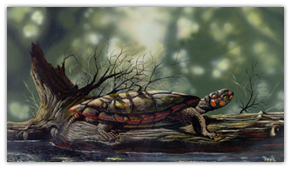 | | Cambaremys langertoni
Fossil turtle collected from Late Cretaceous rocks (c. 70 My) near Uberaba (Minas Gerais, Brazil). Discovered during the nineties by researchers of Centro de Pesquisasa Paleontológicas "Llewelin Ivor Price", it was described by Marco França e Max Langer in 2005. It corresponds to a Podocnemoidae, a turtle group currently known only in the Amazon and Madagascar.
|
| | |
_bair.png) | | Caiman and other cave fossils
Field-work during 2012 e 2013 recovered various Caiman fossils from inside Ioiô Cave, Diamantina Plateau, Bahia. Pleistocene in age, they were collected along with fish, bird and mammal (rodents, bats, carnivores and ungulates) fossils and described in 2014 by Mariela Castro, Felipe Montefeltro e Max langer.
|
| | |
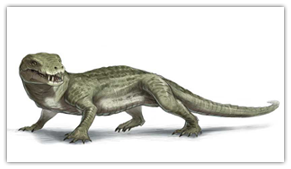 | | Candidodontidae
Candidodontidae were small-bodied crocodyliforms previously known only in Africa and northeastern Brazil. Felipe Montefeltro, Carolina Laurini, and Max Langer described isolated teeth of these animals collected from Late Crateceous rocks (c. 70 My) in São Paulo (southeastern Brazil), extending their geographical range.
|
| | |
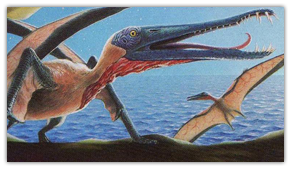 | | Cearadactylus atrox
Pterosaur (flying reptile) collected from Early Cretaceous rocks (c. 110 My) in the Araripe Plateau (Ceará, Brazil). Originally described during the eighties by Guiseppe Leonardi and Guido Borgomanero and recently redescribed by Bruno Vila Nova and co-workers. It was a medium sized, fish eating pterosaur.
|
| | |
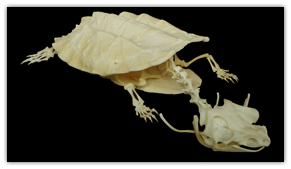 | | Chelus colombianus
Fossil fresh-water turtle found in early Miocene (c. 20 Ma) rocks of northwestern Venezuela. Originally described during the eighties and reviwed by Gabriel Ferreira, Max Langer, and co-workers in 2016. Image on the left shows the skeleton to the amazonian Matamata, living representative of the genus.
|
| | |
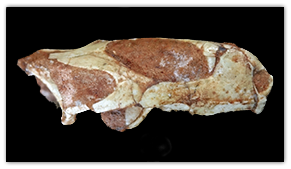 | | Clevosaurus brasiliensis
Sphenodontians are a group of lepidosaurs represented today only by the New Zealand Tuatara, but its fossil record is extencive, including Clevosaurus brasiliensis from the Late Triassic of Rio Grande do Sul. This species was redescribed in 2015, based on new specimens, by Annie Hsiou and co-workers.
|
| | |
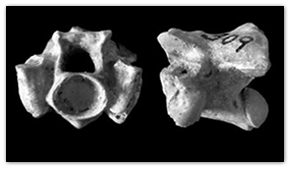 | | Colombophis
Genus of anilioid snake described in the 70ies by Robert Hoffstter and Jean-Claude Rage, and revised during the Ph.D. of Annie Hsiou. It includes two species, C. portai and C. spinosus, from the Miocene of Acre (Brazil), Colombia and Venezuela.
|
| | |
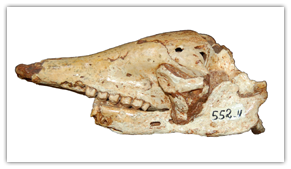 | | Dasypus punctatus
Dasypus, the armadillo know in Brazil as "tatu-galinha" had fossil relatives as this Pleistocene (c. 10.000 years) species. Its better preserved skeleton was collected during the seventies near Sorocaba (São Paulo, Brazil). Originally described by Carlos de Paula Couto, it was redescribed by Mariela Castro, Max Langer and co-workers.
|
| | |
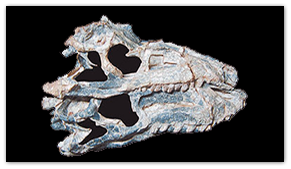 | | Decuriasuchus quartacolonia
Rauisuchian archosaur collected from Triassic rocks (c. 240 My) in the Quarta Colônia area (Rio Grande do Sul, Brazil). Discovered in 2000 by researchers of Fundação ZooBotânica do Rio Grande do Sul, and described by Marco França, Max Langer and co-authors in 2011. Nine skeletons were found together, suggesting a probable gregarious behavior.
|
| | |
 | | Fossil eggs
Fossil eggs are more common that one might guess. Crocodile, turtle, and avian eggs collected between 2008 and 2009 from Cretaceous rocks (c. 80 My) of western São Paulo and the Triângulo Mineiro area (Minas Gerais, Brazil) have been studied by Júlio Marsola, Felipe Montefeltro, Max Langer, Annie Hsiou, and co-workers.
|
| | |
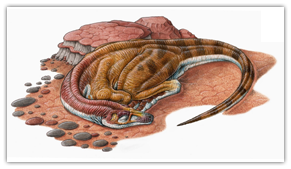 | | Guaibasaurus candelariensis
Early diverging saurischian dinosaur collected from Triassic rocks (c. 220 My) near Candelária and Faxinal do Soturno (Rio Grande do Sul, Brazil). Discovered between 1998 and 2003 by the Argentinean palaeontologist José Bonaparte, and redescribed by Max Langer, Jonathas Bittencourt e co-authors in 2011.
|
| | |
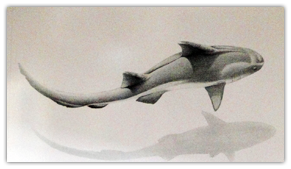 | | Hybodontidae
Hybodontids were medium-sized sharks of broad distribution during the Late Paleozoic and Mesozoic. Teeth and spines of these animals were collected from the Permian rocks (c. 250 My) of Serra do Cadeado area (Paraná, Brazil) and studied by Carolina Laurini and Max Langer.
|
| | |
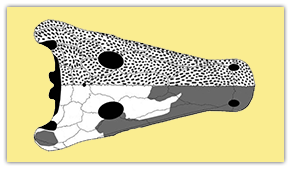 | | Konzhukovia sangabrielensis
Temnospondyl "amphibian" collected from Permian (c. 255 Ma) rocks of Rio Grande do Sul, Brazil. Described by the CAPPA/UFSM Palaeontology team, with collaboration of Estevan Eltink. The genus Konzhukovia was previously known from Russia, suggestion biotic interchange between gondwanan and laurasian landmasses during the late Paleozoic.
|
| | |
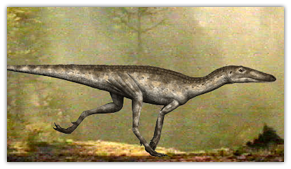 | | Lewisuchus admixtus
Dinosaur-line Archosaur from the Triassic (c. 240 My) of Northwest Argentina. Collected in the 60's by a Harvard University team, it was recently revised by Jonathas Bittencourt, Max Langer and coleagues. Lewisuchus admixtus was a small terrestrian predator with about 1 m length.
|
| | |
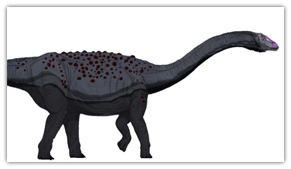 | | Maxakalisaurus topai
Titanosaurid sauropod from the Cretaceous (c. 75 My) of Minas Gerais, Brasil, first described in 2006 by a team of Museu Nacional do Rio de Janeiro. Further jaw specimens were described in 2016 by Júlio Marsola, Max Langer, Annie Hsiou and coleagues from UNIVASF and UFU.
|
| | |
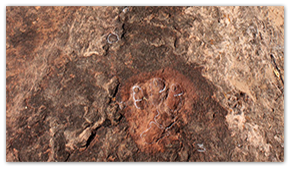 | | Otozoum
Field work between 2013 and 2014 by Simone D'Orazi Porchetti and colleagues in outcrops of the Etjo Formation, in Namibia, led to the description of the first Otozoum trackway from that Formation in the Waterberg area. The presence of this ichnotaxon helps constraining the age of this unit to the Lower Jurassic, and is the first of its kind from Namibia.
|
| | |
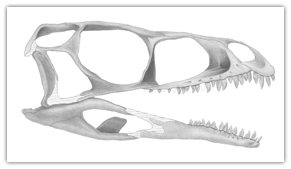 | | Pampadromaeus barberenai
Sauropodomorph dinosaur collected from Triassic rocks (c. 230 My) near Agudo (Rio Grande do Sul, Brazil). Discovered in 2005 by researchers of Universidade Luterana do Brasil and described by Max Langer, Jonathas Bittencourt, and co-authors in 2011. It was a small, about 1.5 m long, herbivorous animal.
|
| | |
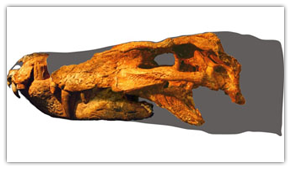 | | Pissarrachampsa sera
Baurusuchid crocodyliform collected from Late Cretaceous rocks (c. 80 My) in the Pontal do Triângulo area (Minas Gerais, Brazil). Discovered and described by Felipe Montefeltro, Max Langer and co-workers between 2008 and 2011. It was a large predator, more terrestrial than modern crocodiles.
|
| | |
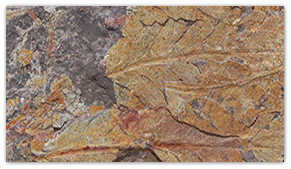 | | Rhachiphyllum schenkii
First record of Callipteridae (Paltaspermales) "gymnosperms" in Brasil. It constrains the age of the Pedra de Fogo Formation to the Early Permian (c. 290 Ma). Collected during 2010, in Maranhão, by the PaleoLab team, and described in 2014 by Max Langer and co-workers.
|
| | |
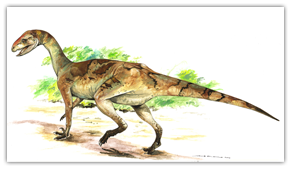 | | Sacisaurus agudoensis
Dinosauromorph collected from Triassic rocks (c. 225 My) in the outskirts of Agudo (Rio Grande do Sul, Brazil). Discovered in 2000 by researchers of Fundação ZooBotânica do Rio Grande do Sul, it was described by Max Langer and co-authors in 2007. The generic name refers to "saci" a mythological figure of Brazilian lore.
|
| | |
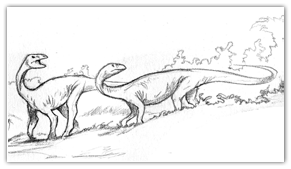 | | Saturnalia tupiniquim
Sauropodomorph dinosaur collected from Triassic rocks (c. 230 My) in the outskirts of Santa Maria (Rio Grande do Sul, Brazil). The three known skeletons were discovered in 1998 by researchers of the Pontifícia Universidade Católica do Rio Grande do Sul and described by Max Langer and co-authors in various papers along 1999 e 2007. It was a small, about 1.5 m long, herbivorous animal.
|
| | |
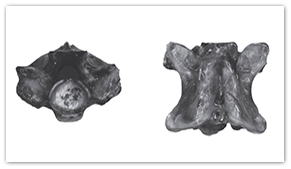 | | Seismophis septentrionalis
The oldest known Brazilian snake, its vertebrae were collected by a team of Universiade Federal do Maranhão in Cretaceous (c. 100 Ma) rocks of the Cajual Island, São Marcos Bay, northern Maranhão, and described by Annie Hsiou and co-workers in 2013.
|
| | |
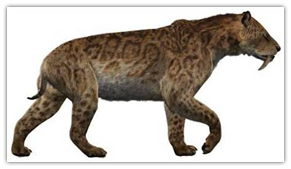 | | Smilodon populator
The famous South-American saber-tooted cat was broadly distributed in Brazilian during the Pleistocene (c. 10.000 years). Its first record in São Paulo corresponds to a skeleton collected by researchers of Museu de Zoologia (USP) and described by Mariela Castro and Max Langer.
|
| | |
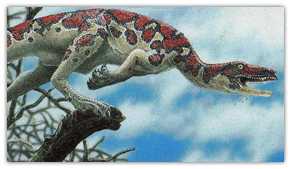 | | Staurikosaurus pricei
One of the oldest known carnivorous dinosaurs; collected in 1934 from Triassic rocks (c. 230 My) near Santa Maria (Rio Grande do Sul, Brazil) during a join expedition of the Departamento Nacional de Produção Mineral (DNPM) and Harvard University, and redescribed by Jonathas Bittencourt and co-authorns in 2008.
|
| | |
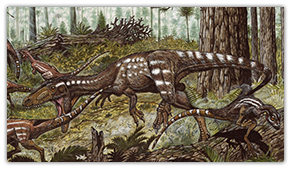 | | Tachiraptor admirabilis
Second non-avian dinosaur (first saurischian) found in Venezuela. Collected during 2012 by a team of the Instituto Venezolano de Investigaciones Científicas, with help of the PaleoLab, from Early Jurassic (aprox. 200 Ma) rocks of the Mérida Hills (northernmost part of the Andes). Described by Max Langer and co-authorns in 2013.
|
| | |
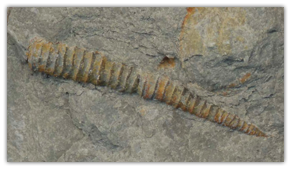 | | Tentaculitoidea
Grup of marine metazoans of uncertain affinities (possibly related to molluscs) with a broad Ordovician to Devonian record. Brazilian fossils of Devoniano (aprox. 400 Ma) age, were reviewed in the PhD thesis of Jeanninny Comniskey.
|
| | |
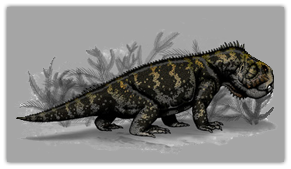 | | Teyumbaita sulcognathus
Rhynchosaur "reptile" collected from Triassic rocks (c. 230 My) near Candelária (Rio Grande do Sul, Brazil). Discovered during the eighties by researchers of Universidade Federal do Rio Grande do Sul, and described by Felipe Montefeltro, Max Langer and co-author in 2011. The genus name means "parrot-lizard" in the indigenous Tupi language.
|

















_bair.png)
























